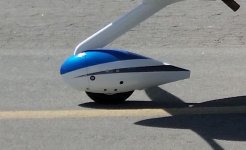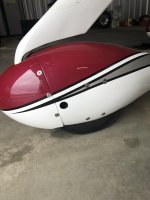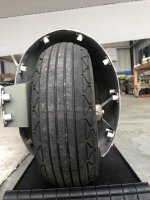Checking -A model nose tire inflation
Has anyone figured out a good way to get a gauge on the nose tire valve stem that is convenient enough to do during your walk-around?
Here's my solution for all the wheel pants, not just the nose wheel shown here:

Sorry, I don't have any photos with the pant off to show the bracket underneath, but I think you'll get the idea. The 4x screws on the main pant hold the mounting bracket to the fairing....they never come off. The bracket/aft fairing slides aft to come off the wheel, after removing the socket head cap screw (that doubles as a Bogart tow bar attach point). Socket head cap screw is the large hole, to the left of the 4x bracket attach screws and just aft of the front cap seam.
As for adding air: the hole to the right of the 4x bracket attach screws lines up with the valve stem when the stem is at the 3 o'clock position. (This did require putting a half circle cutout on the edge of the wheel pant attach bracket on the valve stem side of the tire....again, sorry no photo of the bare bracket.) I use a 10mm socket to remove the (hex head) cap from the valve stem. Then, use a straight air chuck/gauge that has about a 10 inch reach, to put air into the tire. (No idea where you can get the air chuck/gauge I use, since mine came from Avery Tools...and I don't know of anyone else that sells one like it).
So that's it. No fancy Cessna/Piper style pant door. No snap plug to cover the hole. No spring loaded door to have to hold inward while trying to slide the air chuck in. That stuff might look good....but it's kind of a PITA when it comes to checking tire pressure. (The harder you make a maintenance task....the less often that task is likely to be done.) Sure, I probably loose a whopping 0.01 knots, but this system works well for me on all 3 tires.
Semi pro tip: how to know when the valve stem lines up with the fairing hole? Once the stem is aligned with the hole, put a white china marker (aka: grease pencil) mark on the tire side wall, perpendicular to the ground contact point. Then, to find the stem the next time, simply move the airplane forward/aft until the white mark points to the ground. The white mark stays put for WAY longer than any paint mark, about a year if I recall. And, when it starts to turn the same color as the tire...just mark it again.
Finally, the secret location of white china markers seems to be.......Amazon, since none of the usual big box office supply stores near me stocked them, or even listed them in their online stores. You have to buy a whole box.....but you can pass them out to fellow RV owners suffering from "where's the valve stem" syndrome.








